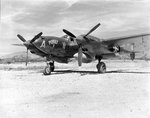Hi,
I have a problem with Maj. Edward Cragg P-38H.
It's very possible that aircraft at this photo is P-38H-1. Number partly obscured by "A" letter ends with "7". That points to factory number 42-66506 (undoubtly P-38H-1).
Now comes the wierd part. As You can see at attached picture, supercharger intake seems to be in new, redesigned shape (like in P-38J/L). Most aviable sources claim, that new supercharger ver. B-33 was installed in P-38H-5 and newer.
My question is: it is possible that P-38H-1 had new intake but old supercharger?
Thanks in advance
Marcin
I have a problem with Maj. Edward Cragg P-38H.
It's very possible that aircraft at this photo is P-38H-1. Number partly obscured by "A" letter ends with "7". That points to factory number 42-66506 (undoubtly P-38H-1).
Now comes the wierd part. As You can see at attached picture, supercharger intake seems to be in new, redesigned shape (like in P-38J/L). Most aviable sources claim, that new supercharger ver. B-33 was installed in P-38H-5 and newer.
My question is: it is possible that P-38H-1 had new intake but old supercharger?
Thanks in advance
Marcin
Attachments
Last edited by a moderator:

